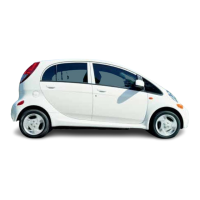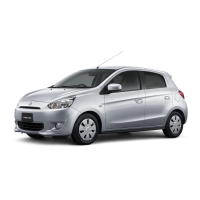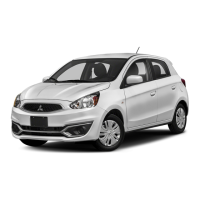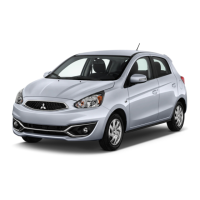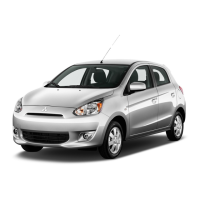O-24 Troubleshooting
6 A rapid tapping sound or clicking sound that becomes faster as the
engine speed increases indicates “valve tapping” or improperly adjusted
valve clearances. This can be identified by holding one end of a section of
hosetoyourearand placing theotherend atdifferentspotsalong the rock-
er arm cover. The point where the sound is loudest indicates the problem
valve. Adjust the valve clearance (Chapter 1). If the problem persists, you
likely have a collapsed valve lifter or other damaged valve train compo-
nent. Changing the engine oil and adding a high-viscosity oil treatment will
sometimes cure a stuck lifter problem. If the problem still persists, the lift-
ers and rocker arms must be removed for inspection (see Chapter 2).
7 A steady metallic rattling or rapping sound coming from the area of the
timing chain cover indicates aworn, damaged or out-of-adjustment timing
chain. Service or replace the chain and related components (Chapter 2).
Cooling system
27 Overheating
1 Insufficient coolant in system (Chapter 1).
2 Drivebelt defective or not adjusted properly (Chapter 1).
3 Radiator core blocked or radiator grille dirty or restricted (Chapter 3).
4 Thermostat faulty (Chapter 3).
5 Fan not functioning properly (Chapter 3).
6 Radiator cap not maintaining proper pressure. Have cap pressure
tested
by gas station or repair shop.
7 Ignition timing incorrect (Chapter 1).
8 Defective water pump (Chapter 3).
9 Improper grade of engine oil.
10 Inaccurate temperature gauge (Chapter 12).
28 Overcooling
1 Thermostat faulty (Chapter 3).
2 inaccurate temperature gauge (Chapter 12)
29 External coolant leakage
Deteriorated or damaged hoses. Loose clamps at hose connections
2Chapter 1).
2 Water pumpsealsdefective. If this is the case, water will drip from the
weep hole in the water pump body (Chapter 3).
3 Leakage from radiator core or header tank. This will require the radia-
tor to be professionally repaired (see Chapter 3 for removal procedures).
4 Enginedrain plugsor waterjacketfreeze plugs leaking (see Chapters
1 and 2).
5 Leak from coolant temperature switch (Chapter 3).
6 Leak from damaged gaskets or small cracks (Chapter 2).
7 Damaged head gasket. This can be verified by checking the condition
of the engine oil as noted in Section 30.
30 Internal coolant leakage
Note: Internal coolant leaks can usually be detected by examining the oil.
Check the dipstick and inside the rocker arm cover for water deposits and
an oil consistency like that of a milkshake.
1 Leaking cylinder head gasket. Have the system pressure tested or i-e-
move the cylinder head (Chapter 2) and inspect.
2 Cracked cylinder bore or cylinder head. Dismantle engine and inspect
(Chapter 2).
3 Loose cylinder head bolts (tighten as described in Chapter 2).
31 Abnormal coolant loss
1 Overfilling system (Chapter 1).
2 Coolant boiling away due to overheating (see causes in Section 27).
3 Internal or external leakage (see Sections 29 and 30).
4 Faulty radiator cap. Have the cap pressure tested.
5 Cooling system being pressurized by engine compression. This
could be due to a cracked head or block or leaking head gasket(s). _.
32 Poor coolant circulation
1 InoperatIve water pump. A quick test is to pinch the top radiator hose
closedwith your hand while theengine is idling, then release it. You shoutd
feel a surge of coolant if the pump is working properly (Chapter 3).
2 Restriction in cooling system. Drain, flush and refill the system (Chap-
ter 1). If necessary, remove the radiator (Chapter 3) and have it reverse
flushed or professionally cleaned.
3 Loose water pump drivebelt (Chapter 1).
4 Thermostat sticking (Chapter 3).
5 Insufficient coolant (Chapter 1).
33 Corrosion
1 Excessive impurities in the water. Soft, clean water is recommended.
Distilled or rainwater is satisfactory.
2 Insufficient antifreeze solution (refer to Chapter 1 for the proper ratio
of water to antifreeze).
3 Infrequent flushing and draining of system. Regular flushing of the
cooling system should be carried out at the specified intervals as de-
scribed in (Chapter 1).
Clutch
Note: A// c/i&h relatedservice information is located in Chapter 8, unless
otherwise noted.
34 Fails to release (pedal pressed to the floor - shift lever
does not move freely in and out of Reverse)
1 Freeplay incorrectly adjusted (see Chapter 1).
2 Clutch contaminated with oil. Remove clutch plate and inspect.
3 Clutch plate warped, distorted or otherwise damaged.
4 Diaphragm spring fatigued. Remove clutch cover/pressure plate as-
sembly and Inspect.
5 Broken. binding or damaged release cable or linkage (models with a
cable-operated release system).
6 Leakage of fluid from clutch hydraulic system. Inspect master cylin-
der, operating cylinder and connecting lines.
7 Air in clutch hydraulic system. Bleed the system.
8 Insufficient pedal height. Check and adjust as necessary.
9 Piston seal in operating cylinder deformed or damaged.
IO Lack of grease on pilot bearing.

